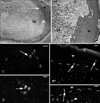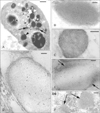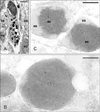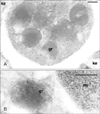Introduction
The capability of lizards to resist infections after large wounds or organ amputation in the tail or limb is in part due to the anti-microbial barrier represented by the epidermis, and to circulating or tissue granulocytes in the dermis [1-3]. Numerous bacteria are found over the exposed tissues of an amputated limb or tail that are in contact with the microbial-rich ground substratum. Lizards are however little affected from these bacteria and heal their tissues with no need for antiseptic treatment, an ability indicating that they possess an effective and rapid innate immunity.
Previous studies have suggested that part of the strong innate immunity in injured lizards derives from the intense activity of granulocytes that destroy bacteria and likely release antimicrobial agents in injured connective tissues present beneath the scab [3-5]. Recent molecular biology studies have indeed found the presence of two types of antimicrobial peptides in lizard wounds and in regenerating tissues, beta-defensins and cathelicidins [6, 7].
Beta-defensins are included in the large family of anti-microbial peptides, with sequences of 18-40 amino acids and containing a characteristic cysteines motif comprising three disulphide bonds [8, 9]. These peptides have been discovered in numerous plants, invertebrates and vertebrates, including reptiles, where they elicit a potent anti-microbial activity (Fig. 1) [6, 10-13]. Beta-defensin peptides derive from a larger protein precursor of 90-110 amino acids, made of 19-20 amino acid signal sequence, a pro-peptide sequence of 45-50 amino acids, and a 32-36 amino acid peptide at the C-terminal, that is cleaved from the remaining protein to produce the mature and active peptide.
Another largely characterized group of antimicrobial peptides present in lizard tissues includes the cathelicidins [7], cathionic peptides of 12-80 amino acids rich in lysine, phenylalanine, trypthophane and proline, and initially synthesized in the cytoplasm of granulocytes as precursors proteins [14, 15]. These peptides also derive from a larger protein precursor. The larger protein contain a pro-peptide sequence and a conserved cathelin domain containing about 100 amino acids that is joined to a terminal amino acid sequence of 12-100 amino acids, the latter corresponding to the mature peptide (cathelicidin). In mammalian cells, the mature peptide derives from the cleavage from the cathelin domain by an intracellular or an extracellular elastase-like protein [16].
In previous molecular studies on lizard anti-microbial peptides we found an expression for both beta-defensins (Ac-BD-15, -25, and -27) and cathelicidins (Ac-CATH-1, -2, -3) in different tissues, including normal and regenerating skin, but the specific cell source for these molecules was not known [6, 7]. These studies have indicated that lizard beta-defensin-27 (Ac-BD-27), together 15, 25, 29, and 30 are the beta-defensins with the larger spectrum of expression in different tissues. Using reverse transcription polymerase chain reaction (RT-PCR) expression analysis of Ac-BD-25 and -27, the study showed that the mRNAs for these two peptides were present in the skin, but only during wound healing and skin regeneration (Dalla Valle et al., unpublished observations). The localization of the more widespread beta-defensin, Ac-BD-15, essentially in granulocytes and phagocytes of Anolis carolinensis [5, 17] suggested that also other beta-defensins could be present in similar cells and become active during wound healing and tissue regeneration. In order to detect the presence and specific localization of other beta-defensins other than Ac-BD-15 the present qualitative study aims to detect the cell localization of Ac-BD-27 within the connective and epidermal tissues of the tail in the lizard A. carolinensis in normal and regenerating conditions.
Materials and Methods
Animals
The study was conducted on adult lizards of the green anolis (A. carolinensis, n=4) maintained in a terrarium at 25-33℃ as previously indicated [5]. The tail was amputated by twisting it to exploit the natural fracture plains present in the tail (autotomous planes) [1]. Despite the little bleeding, some blood was aspirated from the amputation surface of the stump with a Pasteur pipette and fixed into an eppendhorf test tube. Also, pieces of the detached normal tail were sampled for comparison with regenerated tissues (see later).
The animals were left to regenerate their tail at room temperature (25-30℃) in cages. In the first sampling, stumps of healing tails were collected after 4 days post-amputation (wound healing stage), and the same animals were re-sampled after 4 weeks when regenerating tails of 3-5 mm in length were formed. The tissues were immediately fixed for the following immunocytochemical study. Also the blood derived from the second amputation was collected in the fixative solution as indicated above.
Immunocytochemistry and electron microscopy
Tissues were fixed at 0-4℃ in fresh 4% paraformaldehyde in 0.1 M phosphate buffer at pH 7.4 for 7-8 hours, rinsed in buffer, dehydrated in alcohol, and embedded in the resins Lowicryl or LR-White. In three cases also the blood from normal and regenerating lizards (3-4 days after tail amputation) was fixed for 1 hour and then centrifuged in an eppendhorf test tube for 3 minutes at 10,000 g. The supernatant was discharged and the pellet was dehydrated and embedded as indicated above.
The embedded tissues or blood were sectioned using an ultramicrotome, and semithin sections (2-3 µm thick) and thin sections (70-90 nm thick) were collected, stained in 1% toluidine blue for the histological examination or were utilized for the immunohistochemical study. The antibody against BD-27 was raised in a rabbit immunized with a 35 amino acid long peptide (DLECQKAKGLCLHQRCRRPWRSVGTCNNLQHHCCQ) for A. carolinensis beta-defensin-27 (Fig. 1) [6]. The peptides were conjugated to Key Limpet Haemocyanin before injection into rabbits, and the derived antibodies present in the immune serum were purified by affinity chromatography (Davids Biotechnologie, Regensburg, Germany). The reactivity of the immune serum to the antigenic peptides was tested by the manufacturer using the enzyme-linked immunosorbent assay-test.
Light microscope immunocytochemistry was performed incubating the sections overnight at 0-4℃ with the beta-defensin-27 or cathelicidins antibodies diluted 1:200 in buffer (Tris 0.05 M at pH 7.6 containing 1% bovine serum albumin). In control sections, the primary antibody was omitted or pre-absorbed for 24 hours at 4℃ mixing 3:1 of the solution containing the peptide antigen with the purified antibody solution. After rinsing in buffer, the sections were incubated for 60 minutes at room temperature in a fluorescein-conjugated anti-rabbit antibody (1:100, Sigma, St. Louis, MO, USA), rinsed in buffer, mounted in 10% glycerol in phosphate buffered saline, and observed under a fluorescence microscope. Pictures were taken by a digital camera and digitalized into a computer using the Adobe Photoshop Program.
Thin sections of 40-80 nm in thickness were collected on Nickel grids, and the sections were incubated for 10 minutes in the Tris buffer containing 1% Cold Water Fish Gelatin to block non-specific binding sites, then the grids were incubated overnight at 0-4℃ in the primary antibodies (1:200). After rinsing in the Buffer, a 5 or 10 nm gold conjugated anti-rabbit secondary antibody was applied for one hour at room temperature, the grids were rinsed in buffer and stained for 6 minutes in 2% aqueous uranyl acetate, rinsed and observed with a Zeiss 10C/10 CR electron microscope (Zeiss, Jena, Germany). In control sections, the primary antibodies were omitted or pre-absorbed for 24 hours at 4℃ mixing 3:1 the solution containing the antigen with the purified antibody solution. The grids containing the immunolabeled sections were completely scanned checking for the localization of gold particles in all cell types present in the tissues.
Results
Histology and light immunocytochemistry
The tissues of the skin, dermis and epidermis, in the normal tail and the mesenchyme and epidermis present in the regenerating tail were studied under the light microscope. The regenerating tail was formed by a loose mesenchyme at the tip, called the blastema, in contact with a multilayered epidermis, the wound epidermis (Fig. 2A). Although most cells were mesenchymal, sparse blood cells and phagocytes were present in the blastema, and these cells were also localized at the base and sparsely within the wound epidermis (Fig. 2B). The electron microscope study allowed a conclusive identification of cells sparsely located among the keratinocytes of the wound epidermis (arrows in Fig. 2B) as granulocytes (see later description).
The study under the fluorescent microscope of sections of normal and regenerating tail after immunostaining with the Ac-BD-27 antibody showed very few and sparse immunofluorescent cells, more frequently encountered in regenerating then in normal tail tissues. In sections of the blood in normal or regenerating condition, sparse granular cells were also seen (see ultrastructural description). Immunofluorescent cells appeared isolated or, more occasionally, forming small clusters in the inter-muscular connectives, dermis, and especially in the regenerating tail connectives and in the apical blastema, and their cytoplasm contained immunofluorescent granules (Fig. 2C, D). Few immunolabeled cells were also seen within the wound epidermis and also in the epidermis of the regenerating tail during early stages of regeneration (Fig. 2E, F). The nature of these granular cells was better defined using the electron microscope.
Ultrastructural immunocytochemistry
The systematic observation of the entire skin and the muscle tissues located underneath the dermis in all the grids examined under the electron microscope, including the inter-muscle connective tissue with the sparse blood vessels, confirmed that few cells containing medium-dense cytoplasmic granules were immunopositive (Fig. 3A-C). No labeling was present in the dark and ovoidal granules of the frequent melanophores encountered in the dermis and subdermal connectives.
The cells containing variably immunolabeled granules, both present in the isolated blood sections, or within or outside blood vessels in connective tissues and among the mesenchymal blastema showed a relatively smooth surface, and were mainly identified as heterophilic granulocytes (Fig. 3A). Their heterochromatic nucleus was polymorphic and two or more nuclear sections were often seen in these cells. Granules of larger and denser type, probably corresponding to primary (azurophilic) granules of mammalian granulocytes, and other smaller granules with less electron-density, corresponding to the specific granules of mammalian granulocytes, were observed in these cells. The immunoreactivity for Ac-BD-27 indicated that most frequently labeled were the denser and larger granules of heterophil granulocytes while the remaining cytoplasm was immunonegative (Fig. 3B). Other sparsely labeled dense granules showed a reticulate background (Fig. 3C).
Both the cytoplasm and the variably large granules observed in granulocytes from the blood pellets were paler then in granulocytes present among tissues, suggesting a partial extraction of cell components during preparation of the blood pellets. The content of the immunolabeled granules varied from a fine filamentous meshwork (Fig. 3D) to broad pale areas apparently empty with no gold labeling (Fig. 3E). Controls showed no labeling in both cells and granules of granulocytes (Fig. 3F). Small granules, likely corresponding to the specific granules of mammalian granulocytes, were generally unlabeled. Also the rare basophilic granulocytes encountered in tissues or isolated in the blood pellet contained numerous large granules (over 0.5 µm), some of which appeared weakly labeled (data not shown).
Although the normal epidermis did not contain granulocytes, during wounding and regeneration of the tail, sparse heterophilic granulocytes were seen in the basal layers or among suprabasal keratinocytes in apical areas of the wound epidermis (Figs. 2B, 4A). Among their numerous granules, some granules showed a low (few sparse gold particles) to a higher immunolabeling (more numerous and evenly distributed gold particles) (Fig. 4B). Rare granulocytes also possessed heterogenous granules containing a dense core and a paler halo suggesting they belong to the eosinophilic type (Fig. 4C). Sparse granulocytes with labeled large and dense granules were also observed in few instances within the multilayered regenerating (wound) epidermis of the more apical region of the regenerating tail (Fig. 5A, B). Occasional cytoplasmic labeling was seen in these cells although most labeling remained inside the granules.
Discussion
Numerous studies in mammals, lizards, snake and turtle have shown that antimicrobial peptides are mainly stored and released from granulocytes and keratinocytes under microbial challenge [5, 17, 18-22], although other cell types can also form these peptides constitutionally or under microbial or injury challenge [9, 23].
Previous studies on early stages of healing of the skin over the stump of an amputated tail in lizards indicated a massive invasion of granulocytes underneath the scab and infiltrated among migrating keratinocytes and often engulfed with phagocytosed material [3-5, 17]. In the dermis and in normal or regenerating epidermis isolated granulocytes are difficult to be seen under the light microscope. However using the transmission electron microscopy survey these cells can be identified, particularly at the tip of the regenerating tail. The present morphological qualitative study confirms previous observations on the localization of other beta-defensins known to be highly expressed in lizards and other reptiles. In normal conditions both beta-defensins and cathelicidins are stored in heterophilic and basophilic granulocytes while epithelial, connective, muscle cells do not contain or express these peptides. Lizard blood monocytes and macrophages do not appear to contain beta-defensin immunoreactivity.
Also other cell types present in different organs of A. carolinenis, such as liver hepatocytes and macrophages, intestine enterocytes, fibroblasts and cells of the seminiferous tubes in testes, alveolar cells and macrophages in the lung, and cardiomyocytes in the heart, and mucous cells in the tongue, do not usually show any immunolabeling for both beta-defensins or cathelicidins (Alibardi, unpublished observations). Only granulocytes in the blood, in regenerating and normal dermis, and in the regenerating blastema of the tail have shown some immunopositive granules for Ac-BD-15 and -27, and for cathelicidins previously identified by molecular biology methods [7, 24]. In particular, a large immunolabeling of primary granules of granulocytes, intracellular localization and also immunolocalization or released beta-defensins were noticed in activated or degenerating heterophilic granulocytes involved in phagocytosis. This process is very intense in the stump of an amputated tail or limb of lizards during the firts 3-10 days post-injury.
The expression data obtained from different tissues in A. carolinensis by RT-PCR in previous studies [7, 24] probably reflects the content in blood and granulocytes in the tested organs although also other, non hematogenous cells, may become activated under microbial challenge and release antimicrobial peptides. In particular for BD-27 no expression was obtained in the normal skin, intestine and testis, and very weak for other organs. The intestine, liver and normal skin, were also devoid of cathelicidin expression while the regenerating skin showed up-regulation of transcripts for CATH-1 (unpublished data) [7]. However the expression of BD-27 was later observed in the wounded and regenerating skin of A. carolinensis (Dalla Valle et al., unpublished observations).
In the present study, although a variable labeling for Ac-BD-27 was observed in the large granules of lizard granulocytes, the aspect and content of the granules in cells separated from the blood by centrifugation appears as empty, likely due to the loss of some protein content due to the embedding process of the blood pellets during resin penetration. As a result, the granules from the isolated blood granulocytes contained a fine meshwork of filamentous material in a very electron-pale, almost empty matrix. Despite of this apparently poor content preservation the only labeled cell structures were these granules, although the labeling was generally low. It is unknown whether also for lizard defensins, the cleavage is intracellular or extracellular and catalized by a specific granulocyte elastase or serine-proteases like in human and avian granulocytes [16, 25].
Like for the localization of Ac-BD-15, also Ac-BD-27 immunoreactivity is present in wounded and regenerating epidermis, although it appears confined to granulocytes mixed with migrating keratinocytes and is not found within keratinocytes. This immunoreactivity parallels the immunolabeling observed for cathelicidins (Alibardi, personal observations).
In conclusion beta-defensins (and cathelicidins) in lizard tissues appear confined to granulocytes in normal conditions but become activated or their levels increases after wounding and tissue regeneration where also activated keratinocytes produce and likely secrete these peptides to limit microbial invasion or for other, still unknown, biological processes.




 PDF
PDF ePub
ePub Citation
Citation Print
Print







 XML Download
XML Download